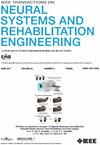外周噪声电刺激对运动学习的神经关联及行为影响。
IF 4.8
2区 医学
Q2 ENGINEERING, BIOMEDICAL
IEEE Transactions on Neural Systems and Rehabilitation Engineering
Pub Date : 2025-03-26
DOI:10.1109/TNSRE.2025.3555203
引用次数: 0
摘要
体感输入在运动学习中起着关键作用。噪声降低了神经的激活阈值,增强了感觉神经元的灵敏度。虽然研究表明,噪声波形的外周电刺激可以改善运动性能和功能,但噪声电刺激对运动学习的影响尚不清楚。本研究旨在探讨外周噪声电刺激对运动学习和相应运动皮层神经活动的直接影响。18名健康成人分别在2天参加了2个实验阶段(即噪音和假电刺激条件)。参与者执行握力跟踪任务,跟踪振幅为10,20和30%的最大自主等长收缩的0.5 Hz连续正弦波,同时记录感觉运动皮层的脑电图(EEG)和右手指屈肌的肌电图(EMG)。计算实际力与目标力之间的差值(力误差),并通过将力误差减小到平台来实现运动学习。运动学习的效率被定义为力误差达到平台的速度。采用重复测量的双向(时间条件[噪声vs假性刺激]]方差分析,比较力误差、EEG功率谱密度(PSD)和EEG- emg(皮质-肌肉)一致性(CMC)的差异。显著性水平设为0.05。噪声电刺激显著降低了运动学习过程中和运动学习后的力误差(p < 0.05),并缩短了力误差达到平台期的时间(p < 0.05);然而,对于先接受假刺激的感知者来说,噪声对学习的影响可能不是最优的,因此不能代表随机共振的净效应。对于大脑中的神经活动,噪声电刺激引起脑电图β (15- 30hz)带和γ (> - 30hz) CMC的立即减少。我们还观察到运动学习导致脑电图PSD β带和伽马CMC的减少。本研究表明,噪声电刺激在运动学习过程中显著减少了学习运动任务所需的时间。我们还发现了与运动学习相关的神经生理特征,包括脑电图功率的不同步以及大脑和肌肉之间功能连接的减少。这些发现可能有助于开发新的运动训练策略和精确干预措施。本文章由计算机程序翻译,如有差异,请以英文原文为准。
The Neural Correlates and Behavioral Impact of Peripheral Noise Electrical Stimulation on Motor Learning
Somatosensory input plays a critical role in motor learning. Noise reduces the neural activation threshold and enhances the sensitivity of sensory neurons. While research has demonstrated that peripheral electrical stimulation with noise waveform improves motor performance and functions, the effects of noise electrical stimulation on motor learning remain unknown. This study aimed to investigate the immediate effects of peripheral noise electrical stimulation on motor learning and corresponding neural activities in the motor cortex. Eighteen healthy adults participated in 2 experimental sessions (i.e., noise and sham electrical stimulation conditions) on 2 separate days. Participants performed a grip force tracking task to follow a 0.5 Hz continuous sine wave with amplitudes of 10, 20, and 30% maximal voluntary isometric contraction while the electroencephalogram (EEG) of the sensorimotor cortex and the electromyography (EMG) of the right finger flexors were recorded. The differences (force error) between the actual and the targeted force were calculated, and motor learning was achieved by reducing the force error to a plateau. The efficiency of motor learning was defined as how fast the force error reached a plateau. Two-way (conditions [noise vs sham stimulation] by time [during vs post]) analysis of variance with repeated measures was used to compare the differences in force error, EEG power spectrum density (PSD), and EEG-EMG (corticomuscular) coherence (CMC). The significance level was set at 0.05. Noise electrical stimulation significantly reduced the force error both during and post motor learning (p <0.05)>30 Hz) CMC. We also observed that motor learning resulted in a decrease in EEG PSD beta band and gamma CMC. This study demonstrated that noise electrical stimulation during motor learning significantly reduced the time required to learn a motor task. We also identified neurophysiological signatures that associate with motor learning, including desynchronization of EEG beta power and reduced functional connectivity between the brain and muscles. These findings could potentially help develop novel motor training strategies and precision interventions.
求助全文
通过发布文献求助,成功后即可免费获取论文全文。
去求助
来源期刊
CiteScore
8.60
自引率
8.20%
发文量
479
审稿时长
6-12 weeks
期刊介绍:
Rehabilitative and neural aspects of biomedical engineering, including functional electrical stimulation, acoustic dynamics, human performance measurement and analysis, nerve stimulation, electromyography, motor control and stimulation; and hardware and software applications for rehabilitation engineering and assistive devices.

 求助内容:
求助内容: 应助结果提醒方式:
应助结果提醒方式:


